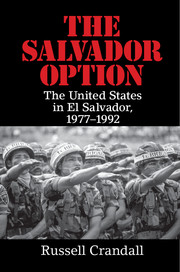Book contents
- Frontmatter
- Dedication
- Epigraph
- Contents
- List of Figures
- List of Organizations
- Acknowledgments
- 1 Introduction
- PART ONE EL SALVADOR IN THE COLD WAR
- PART TWO JIMMY CARTER
- 7 Revolution and Counterinsurgency in Guatemala
- 8 Mass Organizations
- 9 Carter Arrives
- 10 Carter and the Sandinista Revolution in Nicaragua, 1979
- 11 An October Coup
- 12 Carter Engages Salvador
- 13 Archbishop Romero
- 14 Land
- 15 The American Churchwomen
- 16 Arming the Rebels
- 17 Guerrilla Final Offensive, January 1981
- 18 Death Squads
- PART THREE RONALD REAGAN
- PART FOUR GEORGE H. W. BUSH
- PART FIVE POSTWAR
- Notes
- Bibliography
- Index
18 - Death Squads
from PART TWO - JIMMY CARTER
Published online by Cambridge University Press: 05 June 2016
- Frontmatter
- Dedication
- Epigraph
- Contents
- List of Figures
- List of Organizations
- Acknowledgments
- 1 Introduction
- PART ONE EL SALVADOR IN THE COLD WAR
- PART TWO JIMMY CARTER
- 7 Revolution and Counterinsurgency in Guatemala
- 8 Mass Organizations
- 9 Carter Arrives
- 10 Carter and the Sandinista Revolution in Nicaragua, 1979
- 11 An October Coup
- 12 Carter Engages Salvador
- 13 Archbishop Romero
- 14 Land
- 15 The American Churchwomen
- 16 Arming the Rebels
- 17 Guerrilla Final Offensive, January 1981
- 18 Death Squads
- PART THREE RONALD REAGAN
- PART FOUR GEORGE H. W. BUSH
- PART FIVE POSTWAR
- Notes
- Bibliography
- Index
Summary
It is almost a rare thing to die a natural death in this country. It is almost a miracle.
– Auxiliary Bishop Gregorio Rosa Chávez, late 1983 after announcing that that 6,096 people had died of violence in El Salvador that yearIf you had communists in the United States destroying your Golden Gate Bridge and your factories, you'd also hate the communists.
– Hugo Barrera, rightist politicianTerrorism cannot be fought with conventional methods. The only answer is, destroy it. [And to accomplish this] you need excellent intelligence. D'Aubuisson is excellent on that. He's U.S.-trained.
– Guillermo “Billy” Sol, businessman and rightwing political activist and one of D'Aubuisson's earliest backers“Once You Identify Your Enemy, He Will Probably Die”
We have seen that the relationship between the military and the oligarchy dated back at least to the 1930s with a sense of common interest: stopping communism and other threats to their privileged place in Salvadoran society. One explanation for the rise of death squads in the 1970s is that officers realized they did not need the oligarchy to remain in power – and at times social reform was in the military's interest. So the oligarchs created their own paramilitary forces – or death squads – closely or loosely tied to government security forces, most notably the military, often employing off-duty soldiers desperate for a “second income.”
These death squads shared such a deep antipathy for the revolutionary left that they aggressively targeted them starting in the late 1970s. The CIA reported in 1985 that death squads were in fact a function of the small “extreme right” versus the “mainstream right.” Both camps were nationalist and anti-communist but only the extremists were characterized by a “willingness to confront that change with active subversion of the constitutional system and with violent terrorism.” Interestingly, the CIA explained to U.S. officials that the “extreme right” did not “predominate in any one social, economic, or political sector. Rather, it is a fanatic fringe drawn from all elements of society.” This can be explained by the fact that, while few Salvadorans were active in death squads, many more from “all economic classes,” including rural peasantry, quietly condoned their behavior since they thought it was working against the revolutionary left – “however repugnant the methods used.
- Type
- Chapter
- Information
- The Salvador OptionThe United States in El Salvador, 1977–1992, pp. 183 - 198Publisher: Cambridge University PressPrint publication year: 2016

